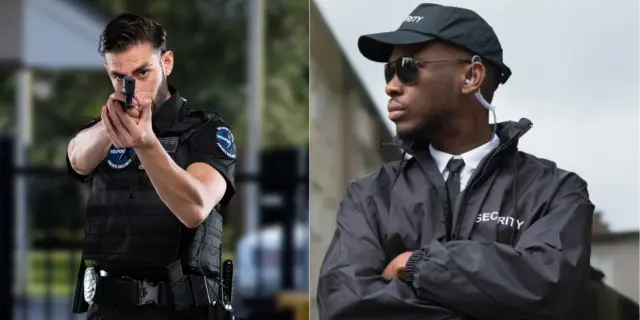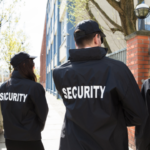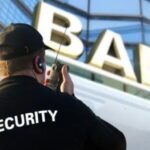Security services are an essential component of maintaining safety and order in various settings, from businesses and events to residential complexes and government facilities. When considering security options, one of the key decisions is whether to hire armed security personnel or unarmed security personnel. In this blog, we will explore the fundamental differences between armed and unarmed security guards, shedding light on their roles, responsibilities, and the factors to consider when choosing between the two.
Armed Security Guard
Armed security personnel are individuals who are authorized and trained to carry firearms as part of their duties. They play a critical role in enhancing security by deterring potential threats and responding to security incidents with the use of firearms, when necessary.
Key aspects of armed security guard
1. Training and Licensing
Armed security personnel must undergo rigorous training, which typically includes firearm safety, marksmanship, conflict resolution, and legal aspects of firearm use. They are also required to obtain the necessary licenses and permits to carry firearms legally.
2. Visible Deterrence
The presence of armed security guard is a visible deterrent to potential wrongdoers. The knowledge that trained personnel with firearms are on site can discourage criminal activity.
3. Response to High-Risk Situations
Armed security guards are prepared to respond to high-risk situations, such as armed intruders or active shooters. They have the capability to neutralize threats and protect lives and property.
4. Specialized Assignments
Armed security personnel are often deployed in high-risk environments, such as banks, government buildings, and high-value asset transport. They are also used in executive protection roles, safeguarding high-profile individuals.
Unarmed Security Guard
Unarmed security personnel, as the name suggests, do not carry firearms as part of their duties. Instead, they rely on their training, communication skills, and other non-lethal tools to fulfill their security responsibilities.
Key aspects of unarmed security guard
1. Training in Conflict Resolution
Unarmed security guard receive training in conflict resolution, de-escalation techniques, and effective communication. They are skilled at diffusing potentially volatile situations without the use of firearms.
2. Access Control and Surveillance
Unarmed security personnel often focus on access control, monitoring CCTV systems, and conducting regular patrols to ensure the safety and security of a property. Their primary role is to observe, report, and deter through their presence.
3. Customer Service
Unarmed security guards often serve as the initial point of contact for visitors, tenants, or event attendees. They provide information, directions, and assistance, contributing to a positive and welcoming environment.
4. Emergency Response
While unarmed security guards do not carry firearms, they are trained in emergency response procedures, including first aid and CPR. They can assist in medical emergencies and coordinate with law enforcement when necessary.
Factors to Consider Before Choosing Between Armed and Unarmed Security Guards
Risk Assessment: Assess the specific security needs of your location or event. If there is a high risk of armed threats or violence, armed security may be more appropriate. For lower-risk environments, unarmed security can be sufficient.
Budget: Armed security typically comes at a higher cost due to the specialized training and licensing requirements. Consider your budget constraints when making a decision.
Legal and Regulatory Requirements: Research and comply with local, state, and federal laws and regulations regarding the use of armed security personnel. Ensure that you meet all legal requirements for either option.
Public Perception: Consider the impact on the public’s perception. While armed security can provide a sense of safety, it may also create anxiety in some situations. Unarmed security personnel may offer a more approachable and less intimidating presence.
Nature of the Property or Event: The nature of the property or event plays a crucial role. For example, a bank or jewelry store may require armed security due to the high value of assets, while an art gallery may prefer unarmed guards to maintain a peaceful atmosphere.
Response Time: Evaluate the response time of local law enforcement. In areas where police response times are relatively quick, unarmed security may be sufficient for initial response, while waiting for law enforcement to arrive.
Conclusion
The choice between armed and unarmed security guards depends on various factors as mentioned. Armed security offers a visible deterrent and the ability to respond to high-risk situations with force, while unarmed security relies on training in conflict resolution, access control, and surveillance to maintain safety and security. Ultimately, the decision should be made after a thorough assessment of the specific security needs of your situation, ensuring that your choice aligns with your goals of protecting people and property effectively.
FAQs
Armed security guards undergo rigorous training that includes firearm safety, marksmanship, conflict resolution, and the legal aspects of firearm use. They must also obtain the necessary licenses and permits to carry firearms legally.
Yes, in some cases, a combination of armed and unarmed security may be appropriate. For example, armed security can provide initial response in high-risk situations, while unarmed security personnel can handle access control and customer service in lower-risk areas of the same property or event. This approach balances security needs efficiently.
Armed security guards are trained to carry firearms, but they don’t necessarily have their firearms drawn or visible at all times. The presence of the firearm is typically concealed, and they use it only when faced with a legitimate threat.
The training of security personnel, whether armed or unarmed, is essential for their effectiveness. While armed security personnel receive specialized training in firearm use, unarmed security personnel are trained in areas such as conflict resolution, access control, and surveillance, making them well-equipped for their roles.
Unarmed security personnel are trained in conflict resolution, de-escalation techniques, and effective communication. They rely on their skills to diffuse volatile situations peacefully and may also use non-lethal tools like pepper spray or batons when necessary.





